Just as the autumn comes, Bengalis start their countdown to their biggest festival, the Durga Puja. And where better to experience it than in Kolkata, the cultural capital of India.
During the period of Durga Puja, the city of joy turns itself into an open art exhibition. Pandals get installed, streets get illuminated and alponas(rangoli) get drawn. Every street gets brightened up with pandals and each of them tells a story, echoing the creativity and hard work of the people who pour their hearts into every detail.
Experiencing Durga Puja in Kolkata is more than just attending a festival, it’s stepping into a vibrant world of creativity, devotion and togetherness.
For anyone looking to truly understand Bengali culture, and experience Bengal’s creativity, then this is the experience they need to have at least once.
The emotions, the connections, and the sheer beauty of it all will leave an imprint on your heart forever.
5 Reasons To Experience Kolkata’s Durga Puja
1. The Significance of Durga Puja
In the durga puja, we worship Goddess Durga, the goddess shakti (power). It celebrates the triumph of Goddess Durga over the buffalo demon, Mahishasura, symbolising the victory of good over evil.
In most parts of India, the festival is celebrated as Navaratri, which is celebrated over 9 days, but Bengali Durga Puja, the celebration is of 5 days only, starting from the 6th day to the 10th.
I have seen puja since childhood, heard stories from Grandma, and was even part of the puja. But still I would not claim to be an expert in explaining the rituals, but I have gained certain expertise reading few blogs, and watching Youtube
Let’s dive into the significance of each day of Durga Puja:
Mahalaya: The Beginning of Devi Paksha
Mahalaya, a day that marks the beginning of Devi Paksha (the fortnight dedicated to the Goddess).
Just as the dawn approaches, we Bengali turn on our radio set, or now a days mobile or even television set to hear the famous Mahishasura Mardini. The version recorded by Birendra Krishna Bhadra, has become an integral part of the Durga puja celebration.
This is the day when artist paints the eye on the idol, which is known as Chokkhu Daan, symbolising the awakening of the mother goddess.
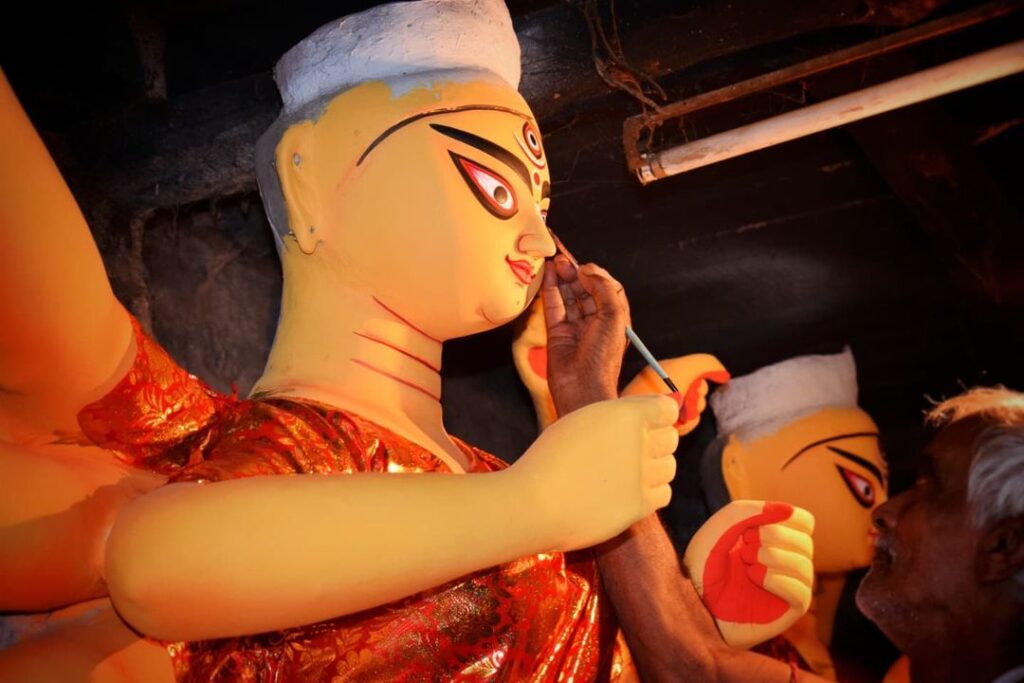
Another key aspect of Mahalaya is the offering of Tarpan at the banks of rivers, particularly the Ganges.
If you are in Kolkata, you can find people doing this ritual in the banks of river Hooghly. The ritual symbolises gratitude and is a way to seek blessings from departed souls for a prosperous future.
If you want to explore the spiritual part of the festival, you can simply ask local pujo pandals and join them to become part of the celebration
Shosti: Welcoming the Goddess
During our childhood I used to hear that Maa Durga comes from Kailash and she rests under the Banyan tree (Beltala).
Durga Puja officially begins on Shosti, the sixth day of Navratri. Shosti is all about welcoming the goddess into our homes and lives with open arms.
Sosti starts with Bodhan. This ritual involves the unveiling of the face of Goddess Durga. It symbolises her arrival on Earth from her heavenly abode. The Bodhan ceremony is performed in the evening, and it is a significant moment as it marks the formal beginning of Durga Puja.
Then there are several other rituals such as Kalparambha, this is the preliminary ritual performed early in the morning, which includes the setting up of the sacred pot (ghat) and other preparations for the puja.
Then we have Amantran and Adhivas. These rituals involve inviting the goddess and consecrating the area where she will be worshipped. Special prayers and offerings are made to invoke her presence.
As the puja begins, the city starts hopping from pandal to pandal, there’s a growing sense of anticipation in the air.
Everyone gears up for the festivities ahead, with streets becoming more lively and the sound of dhak (traditional drums) reverberating throughout Kolkata.
Saptami: The Day of Invoking Power
Saptami is the second day of Durga Puja. Early in the morning, a ritual called Nabapatrika is performed, where nine different plants, representing the nine forms of Goddess Durga, are tied together and bathed in the holy Ganges water.
One of the nine plant is Banana plan which is Kola Bou means Banana Bride. It is wrapped in a sari and placed next to Lord Ganesha, symbolising his wife.
Then we have Pran Pratishtha, which is the ritual of invoking life into the idol of Goddess Durga. This signifies the formal invocation of the goddess’s energy into her idol.
For many, Saptami is when the real fun begins. The city gears up for 24-hour pandal hopping, and the streets are filled with families, friends, and visitors. The stunning pandals are open for display, showcasing creativity and art in their full glory.
Ashtami: The Peak of Devotion
Ashtami is considered the most auspicious day of Durga Puja. It is on this day that Goddess Durga is worshipped in her fiercest form, Maha Ashtami.
The day begins with Pushpanjali (flower offerings) where devotees offer flowers to the goddess while chanting sacred mantras.
This day also involves Kumari Puja. This ritual involves worshipping young girls, symbolising the divine feminine power.
The girls are dressed as the goddess and offered prayers, food, and gifts. This ritual highlights the purity and power of the goddess in her youthful form.
Ashtami is also when women participate in Dhunuchi Naach, dancing with incense-filled earthen pots in front of the goddess, adding to the vibrant energy of the day.
In the evening, the grand Sandhi Puja is performed, marking the moment when Ashtami turns into Navami.
This is when Durga, in her Chamunda avatar, is said to have slain Mahishasura’s two generals, Chanda and Munda.
During Sandhi Puja, devotees fast from Ashtami until Navami, purifying themselves for the goddess’s blessings. The lighting of 108 diyas symbolises the triumph of light over darkness, and the ulu dhoni wards off negativity. Offerings of 108 lotus flowers, garlands, and sarees represent Durga’s many forms.
The shankh is blown, and the ritual ends with an aarti and havan, creating a truly soul-stirring experience.
Navami: Continuing the Festive Spirit
The ninth day, or Navami, continues the spirit of worship with full force.The rituals are similar to Ashtami, but you can feel the festival gradually winding down.
For devotees, Navami is about honouring the power and victory of the goddess, and many partake in the lavish bhog—a feast served as an offering to the goddess and distributed to devotees.
The streets remain crowded with pandal hoppers eager to make the most of the final hours of the festival.
Dashami: The Farewell
Finally, Dashami, or Vijaya Dashami, marks the end of Durga Puja. This is the day when Goddess Durga returns to her heavenly abode, and the city bids her farewell with mixed emotions.
During Bijoya Dashami, it is a common ritual where married women use a paan leaf (betel leaf) to gently clean the face of the idol of Lord Ganesha, Goddess Durga, Goddess Lakshmi, Goddess Saraswati, Lord Kartikeya, and even Mahisasur.
After gently wiping the face with betel leaf, women apply sindoor (vermilion) to Maa Durga’s forehead and offer sweets, such as nadu (a traditional Bengali sweet made from coconut and jaggery) and touches here feet for blessings. This ritual is performed with great devotion and is accompanied by the heartfelt plea, “Abar esho” (Come again), asking the goddess to return the next year. This is done to all the three godess.
This marks the beginning of the goddess’s send-off, a mix of devotion and celebration.
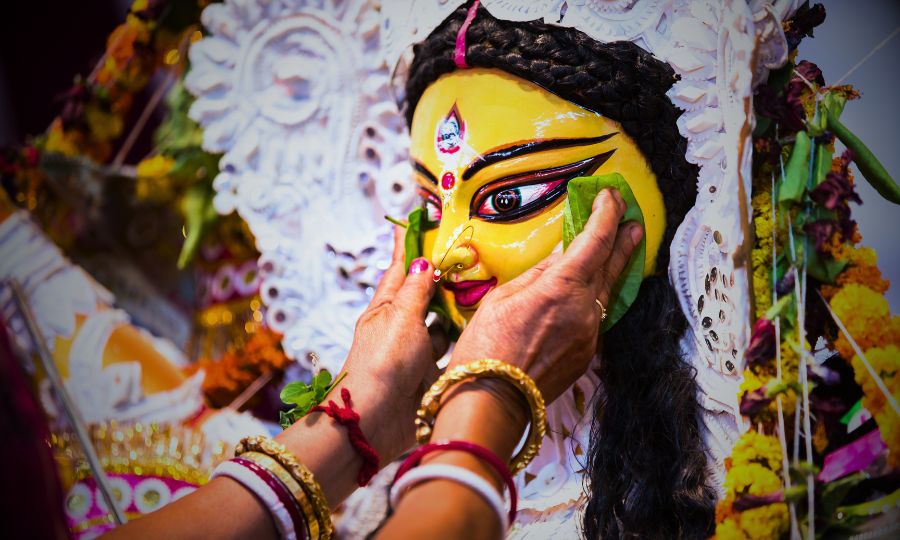
The second most important highlight of Dashami is the Sindoor Khela, a ritual where married women smear each other with sindoor (vermillion), symbolising the wish for long marital life and prosperity.
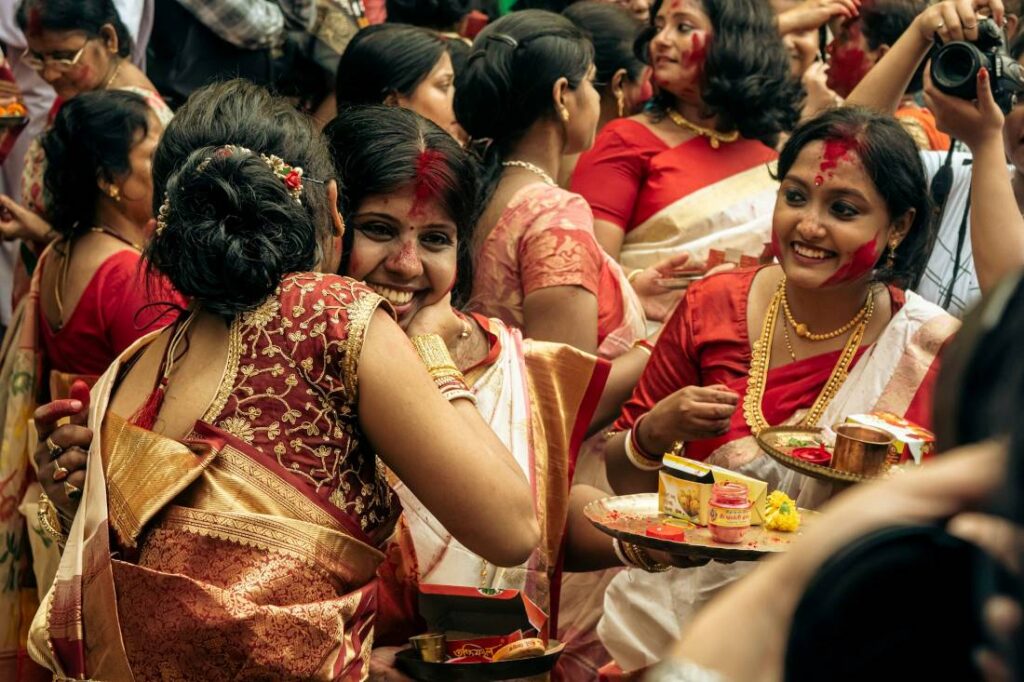
In the evening, the idols are taken for Visarjan (immersion) in the rivers and lakes of Kolkata. As the chants of “Asche Bochor Abar Hobe” (Next year, we will celebrate again) fill the air, there’s both a sense of sadness and hope.
The immersion of the idols marks the conclusion of Durga Puja, but the memories and energy of the festival remain in the hearts of all who witness it.
You can immerse yourself in these cultural experience by simply connecting with any local Puja pandal.
2. Pandal Hopping During Kolkata’s Durga Puja
Durga Puja is celebrated by Bengalis all over India and abroad, so to become part of the Puja you can do it anywhere, whether it’s in Mumbai, Delhi, Bengaluru or any other cities. However, what sets Kolkata’s Durga Puja apart from the rest is the stunning array of Puja pandals.
Pandal hopping is at the heart of Durga Puja in Kolkata, and it’s nothing short of a cultural spectacle.
Every neighbourhood across the city competes to create the most innovative and awe-inspiring pandals, temporary temples that house the idols of Goddess Durga.
These pandals are more than just places of worship; they are grand, artistic installations, each telling its own unique story.
In my experience, no two pandals are alike. One moment you’re walking into a pandal that looks like a traditional palace, and the next, you’re exploring one made entirely of eco-friendly materials like bamboo or clay.
In recent years, theme puja has become a popular trend in Kolkata. Pandal committees create pandals using innovative concepts, transforming the festival into a visual spectacle.
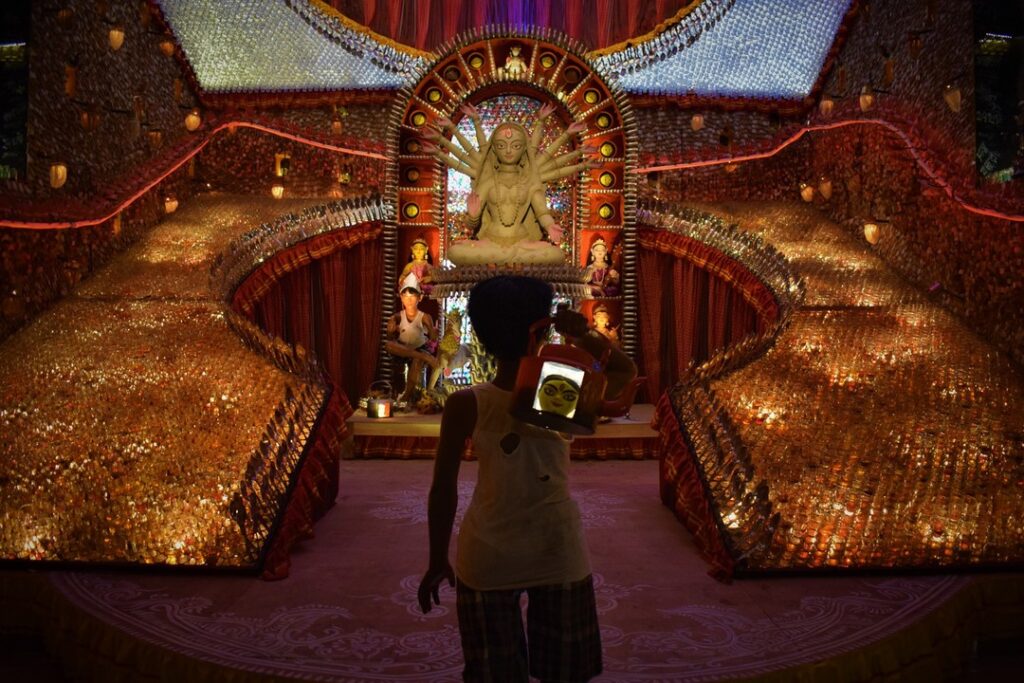
Creating social and environmental themes to build awareness has now become popular across the city.
The artistry doesn’t stop with the pandals themselves. The majority of the idols of Goddess Durga, handcrafted in Kumartuli, the city’s potter’s village, are a breathtaking fusion of devotion and craftsmanship.
Watching the idols being shaped from clay into divine figures is a mesmerising experience, and it’s something you can only fully appreciate while pandal hopping.
Presently the idols of the mother goddess have also been incorporated into the theme.
And then there’s the city itself. As night falls, Kolkata lights up like a festival of its own. Streets are illuminated, people are dressed in their finest, and the air is filled with the hum of excitement.
I remember in my childhood, we used to sit down and plan our Puja itinerary. We would say, “We’ll visit the North during Shosti, the South on Saptami, and then cover the rest on Ashtami, finishing with local puja hopping on Navami.”
Even today, that is the right way to do it.
Few tips for Pandal Hopping from me
- Use public transport (local, metro, bus and auto rickshaws)
- Recharge or buy a metro card, now you can even book a ticket from the metro app. This will help in avoiding long queues on metro counters.
- Same for the local train, install UTS app.
- Start pandal hopping from Chaturthi night, as it’s less crowded.
- If renting a cab, try to book it around 3 AM for fewer crowds and beautiful lighting in the pandals (except on Ashtami and Navami).
- Don’t attempt to cover the entire city in one go.
- Take breaks while hopping pandals.
- Split the city into five parts, based on which cover your pandals.
- Bonus Tip: You can buy Durgotsav Forum VIP Passes, or magazines like Debi Pranam and Sananda Puja Special for VIP Passes.
Whether you’re visiting for the art, devotion or to experience the atmosphere, pandal hopping during Durga Puja is an unforgettable adventure.
Recently, for the past few years, the West Bengal government has been organizing a grand Durga Puja Carnival. In this event, selected few Puja committees from across Kolkata and other parts of the state are invited to showcase their artistic and thematic representations of Goddess Durga on their way to Bisarjan, this usually happens during a weekend after Vijaya Dashami
3. The Community and Social Aspect
Kolkata’s Durga Puja is more than just a festival; it’s a time when the community comes alive. When you step into a pandal, you can feel the energy of people celebrating together. It’s like a big reunion, where friends and families gather to share the excitement of the festivities.
Each pandal showcases the hard work of local communities. Everyone joins in, whether it’s designing the idol, decorating the space, or organising events. You can see their pride as they display their creativity, making each pandal a unique experience.
The festival brings people together, breaking down barriers. Young and old, neighbours and newcomers all come together to enjoy the joy of the celebration. You’ll find people chatting, sharing food, and dancing to the lively beats of the drums. This sense of unity turns the city into a vibrant place of festivities.
Social gatherings play a big role, too. From cultural performances to community meals, everyone feels included. Whether you’re joining in traditional dances or enjoying bhog with others, you’re part of something bigger.
For many, Durga Puja is not just about religion; it’s a chance to reconnect with their culture and roots. The community spirit during this time creates lasting memories, reminding us of the importance of togetherness. So, as you explore the bustling pandals, take a moment to appreciate the friendships and connections that define Kolkata’s Durga Puja. It’s an experience you won’t forget.
4. The Culinary Delights
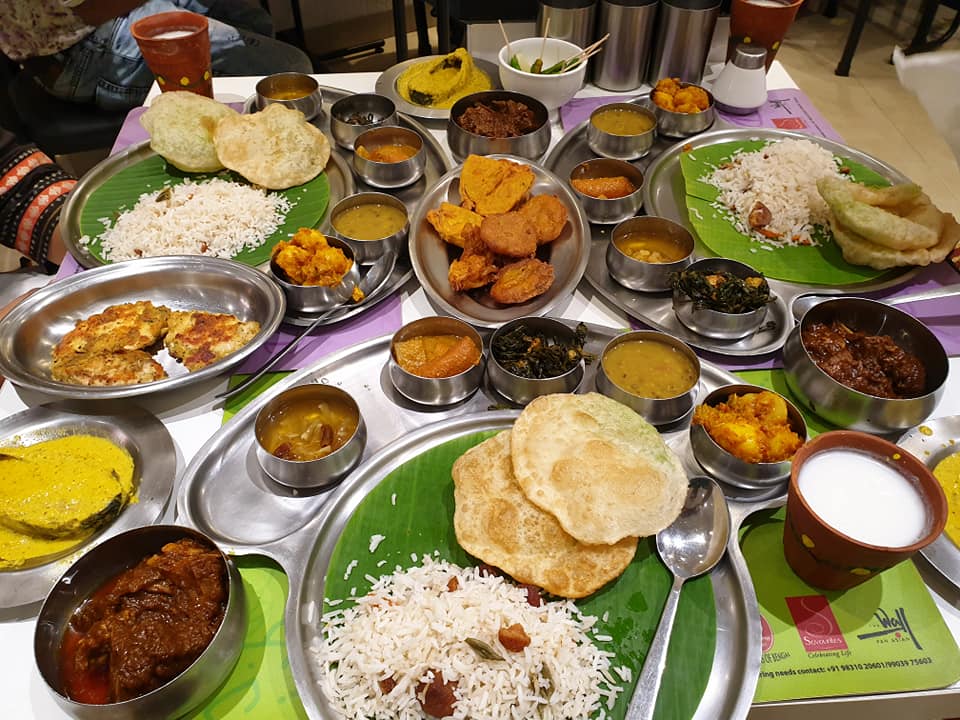
Bengalis are foodies, so you can not expect their biggest festival to be without food.
So, if you’re in Kolkata during Durga Puja, your taste buds are in for a treat! Food is an essential part of the celebration.
The traditional bhog, which is prepared with great love and devotion mainly consisting of Khichuri along with vegetables, sweets and payes (kheer) is one of my favourite and you will love it.
Food lovers don’t just spend queuing in pandals but also queuing for the restaurant. Yes, as the lunch/dinner time approaches, you will expect long queues outside the restaurant.
As a vegetarian I have some minor advantages, as most of the crowd is for non-veg food which are traditional Bengali thali, and the most popular item Biriyani, so non-veg restaurants remain crowded where as you can find little less crowd in pure veg restaurant.
And, of course, the street food stalls that line the roads are irresistible. From delicious roll, to vegetable chop, the culinary diversity will leave you coming back for more.
So if you are planning to grab lunch and dinner during puja, you should check if the restaurant has booking features, in that case book your table. There are several apps available like Zomato, Swiggy where you can book your table.
5. The Immersive Experience
Kolkata during Durga Puja is a city that doesn’t sleep. The streets come alive with night markets, cultural performances, and the unmistakable sound of dhak (traditional drums).
Although I do tend to avoid crowds and do my pandal hopping during morning hours, I remember the first time I stood in a crowd holding hands of my parents, surrounded by people everywhere, with only hearing the rhythmic beats of the dhak, and some Shehnai which I don’t know why it is so popular, but the overall energy energy is infectious.
Metros stops running during morning hours and runs all night instead.
Wrapping Up
Exploring the city, I’ve found that Durga Puja is the perfect opportunity to immerse yourself in Bengali culture. The streets are packed with people from all walks of life, and the warmth and hospitality of the locals make the experience even more special.
Every pandal feels like an art exhibition, and the festival offers the perfect chance to connect with people, both locals and visitors alike.
It is in fact not just a festival; it’s a cultural immersion that leaves an impact on your soul. From the visually stunning pandals to the delicious food, and the endless joy in the streets, it’s an experience that stays with you.
Whether you’re a first-timer or a seasoned traveller, Durga Puja in Kolkata will make you feel like you’re part of something bigger than yourself.
So, what are you waiting for?
Pack your bags and book your tickets—this is one festival you won’t want to miss. Believe me, once you experience it, you’ll want to come back every year.
![]()

